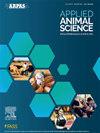Longitudinal assessment of Fusobacterium necrophorum and Fusobacterium varium in the nasal cavity of finishing beef steers with and without liver abscesses
IF 1.5
Q3 AGRICULTURE, DAIRY & ANIMAL SCIENCE
引用次数: 0
Abstract
Objective
We longitudinally assessed the prevalence of Fusobacterium necrophorum ssp. necrophorum, Fusobacterium necrophorum ssp. funduliforme, and Fusobacterium varium in the nasal cavity of finishing beef steers with and without liver abscesses (LA).
Materials and Methods
Crossbred beef steers (n = 225; arrival BW = 353 ± 39.6 kg) were transported to a feedlot and used in a case-control study. From d 0 to harvest, steers were fed a feedlot diet representative of the High Plains region (NEg = 1.50 Mcal/kg). Nasal swabs were aseptically collected after feedlot arrival (d 5), after adaptation to the finishing diet (d 35), and the day before harvest (harvest). Livers were collected at harvest and examined for LA, and cattle were subsequently assigned into either case (LA present) or control (LA not present) groups. Nasal swabs from cattle with LA (n = 42) and without LA (n = 42) were analyzed for Fusobacterium. Individual animal was the experimental unit, with fixed effects of abscess, sampling time, and abscess × sampling time interaction.
Results and Discussion
Overall LA prevalence was 18.7%. Nasal prevalence of F. necrophorum ssp. necrophorum and F. varium did not differ by LA status or sampling period. Conversely, an abscess × sampling interaction occurred, where steers with LA had lesser F. necrophorum ssp. funduliforme prevalence on d 35 than those without a LA. Nevertheless, the number of enumerable F. necrophorum ssp. funduliforme samples did not differ between steers with or without LA or across sampling time.
Implications and Applications
This is the first report of Fusobacterium detection and enumeration from the nasal cavity of feedlot beef steers. Although these data suggest that Fusobacterium species are present in the nasal cavity of finishing beef steers throughout the feedlot period, a direct link between nasal Fusobacterium populations and LA development was not detected. High variability and small sample sizes limited our ability to detect subtle associations. Future research is needed to evaluate relationships between Fusobacterium populations in the respiratory tract, respiratory disease prevalence, and LA formation.
有肝脓肿和无肝脓肿的育肥牛鼻腔内坏死梭菌和变异梭菌的纵向评估
目的对necrophorum Fusobacterium ssp的流行情况进行纵向评估。坏死性梭杆菌;有肝脓肿和无肝脓肿的育肥牛(LA)鼻腔中有底状菌和各种梭杆菌。材料与方法将225头出生体重为353±39.6 kg的杂交肉牛运到饲养场进行病例对照研究。从第0天至收获期,饲喂具有高平原地区代表性的饲粮(NEg = 1.50 Mcal/kg)。到达饲养场后(第5天)、适应饲粮后(第35天)和收获前一天(收获)无菌收集鼻拭子。在收获时收集肝脏并检查LA,随后将牛分为病例组(有LA)或对照组(没有LA)。对患有LA的牛(n = 42)和未患有LA的牛(n = 42)的鼻拭子进行梭杆菌分析。动物个体为实验单位,脓肿与采样时间固定,脓肿与采样时间交互作用。结果与讨论总体LA患病率为18.7%。坏死性镰孢杆菌的鼻腔患病率。necrophorum和F. varum在LA状态和采样时间上没有差异。相反,发生脓肿与采样的相互作用,其中LA的公牛有较小的坏死乳杆菌。35岁时基底形成的患病率高于没有LA的患者。然而,可计数的尸霉属的数量。基底形成样本在有或没有LA或采样时间之间没有差异。意义与应用本文首次报道了从饲养场肉牛鼻腔中检测和枚举梭杆菌。虽然这些数据表明,育肥牛在整个饲养场期间的鼻腔中都存在梭杆菌,但没有发现鼻梭杆菌种群与LA发展之间的直接联系。高变异性和小样本量限制了我们发现微妙关联的能力。未来的研究需要评估呼吸道中梭杆菌种群、呼吸道疾病患病率和LA形成之间的关系。
本文章由计算机程序翻译,如有差异,请以英文原文为准。
求助全文
约1分钟内获得全文
求助全文

 求助内容:
求助内容: 应助结果提醒方式:
应助结果提醒方式:


